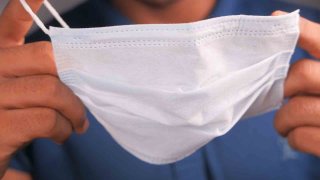
The new year is kicking off with a spike in respiratory illnesses across the U.S., including COVID-19, flu and respiratory syncytial virus. Considering all the circulating illnesses right now, it might be time for masking to make a comeback, experts say.
"We're certainly in the winter peak of respiratory viruses," Dr. Albert Ko, professor of epidemiology and medicine at the Yale School of Public Health, tells TODAY.com. A post-holiday COVID spike alongside upticks of the usual winter illnesses, like flu and RSV, make this surge "very much expected," he adds.
Amid this rise in the spread of illnesses, mask mandates are already back in some health care settings, including hospital systems in Los Angeles County and New York City. And many of us should probably follow suit, Ko says.
Wearing a mask amid a spike in respiratory viruses is "kind of a common sense thing," Dr. Joseph Khabbaza, a pulmonary and critical care specialist at the Cleveland Clinic, tells TODAY.com, like using a parachute when jumping out of a plane.
Khabbaza, who works in both outpatient settings and the intensive care unit, has been seeing more cases of COVID-related pneumonia since about November, he says. After seeing very few cases for over a year, "We have a couple of patients in the ICU (with COVID pneumonia) almost every day that I've been on the last two months," he explains.
While the situation isn't as severe as it was at the beginning of the pandemic, there has been a noticeable uptick in serious cases in the hospital, Khabbaza says. During the week ending on Dec. 30, 2023, the Centers for Disease Control and Prevention saw a more than 20% increase in COVID hospitalizations.
He tells TODAY.com that he's also seeing more cases of RSV-related airway inflammation, and flu-related complications are beginning to tick up as cases increase across the country. "We're really seeing a nice combination of all three of those ending up in the hospital right now," Khabbaza says.
Health
With illnesses so widespread, here's what to know about wearing a mask amid this 2024 COVID-19 surge.
Is there a COVID surge right now?
Feeling out of the loop? We'll catch you up on the Chicago news you need to know. Sign up for the weekly Chicago Catch-Up newsletter.
We are currently experiencing a major COVID-19 surge in the U.S., second only to the first omicron surge that occurred in late 2021 and early 2022, TODAY.com previously explained.
But experts stressed that it’s more important to focus on how widespread COVID-19 has been over the course of months, rather than just looking at the height of a particular peak in the surge.
Data from the CDC show that COVID-19 viral activity in wastewater is at a very high level right now, and has been steadily increasing since October.
JN.1 COVID variant causing more cases
Another factor in the current surge is that newly emerged coronavirus strains are even more infectious. The most recent CDC data suggest that the highly contagious JN.1 coronavirus variant is responsible for most cases right now, accounting for nearly 62% of COVID-19 cases in the U.S. The HV.1 variant, which was previously the dominant strain, now only accounts for about 15% of cases.
"The current strain right now seems to be packing a meaner punch than the prior strains," Khabbaza says. "Some features of the current circulating strain probably (make it) a little bit more virulent and pathogenic, making people sicker than prior (variants)."
But it's not just about COVID. "With all the respiratory viruses coming back with a vengeance it's not just COVID that we need to worry about," Dr. Bernard Camins, medical director for infection prevention at the Mount Sinai Health System, tells TODAY.com.
Over the last few years with pandemic precautions in place, "the usual proportion of people who get exposed to flu or RSV or rhinovirus (a common cold virus) have not been exposed," he explains. So our defenses against those illnesses may be reduced.
Should you wear a mask due to COVID?
During the early years of the pandemic, we saw how effective precautions like social distancing and widespread masking were at reducing the spread of not just COVID-19, but other illnesses as well, Ko says.
While masking isn’t 100% effective at preventing transmission of COVID-19, it can reduce the amount of virus you’re exposed to, Ko says. That’s important because even the immunity we have from vaccines can be “overwhelmed if you encounter large doses of a virus,” explains. So, wearing a mask can be beneficial — even if you’re up-to-date on vaccines.
If you have symptoms of a respiratory illness but still need to be around other people, you should wear a mask. People who have tested positive for COVID-19 still need to wear a mask around others for a full 10 days, according to CDC guidelines.
"The ideal situation is people who are not sick enough to stay home but have some respiratory symptoms should put a mask on to protect others from getting sick," Camins says.
With such high levels of illness spreading, it’s also a good time for people who aren’t sick but want to protect themselves to consider wearing a mask in crowded, indoor settings, Camins says.
If you're not sick, the decision to wear a mask or not should depend on your individual risk factors, level of risk tolerance and the other protections you're taking, such as staying up-to-date on vaccinations, Khabbaza says.
People who are at a higher risk for severe complications of respiratory illnesses like flu and COVID, including transplant patients and other immunocompromised people, should be taking extra precautions like masking, Khabbaza explains. "These are people that have never really been out of the woods these last three years in terms of risk," he says, "and those are the ones I always worry about and think about the most."
Elderly folks as well as those with other underlying conditions — such as diabetes, heart disease and asthma — that increase their risk for flu and COVID complications should also "really be thinking about" taking precautions like masking, Ko says.
Additionally, if you'll be spending time with people who are higher risk, it's a good idea to take those extra precautions yourself, Khabbaza says. If you have those risk factors or live with someone who does, "masks are one way to protect yourself and your loved ones," Ko agrees.
Travel is another area where it makes sense to wear a mask. “Masking on the airplane, especially right now with community spread being so high, might be pretty smart,” Ko says. Even if you don’t get severely sick, “if you get to your destination and you’ve got a flu-like illness for a couple of days, you’ve kind of lost your vacation,” he adds.
Out in public, other people are less likely to be masked, so it’s more important that you’re wearing a higher-quality mask to stay safe, Camins adds. “In that case, if you want to protect yourself, it’s better to actually wear a more protective mask, like an N95 or KN95.”
How long are people contagious with COVID?
"These new variants tend to cause disease more rapidly after infection and also become more contagious after you've been exposed," Ko says.
But they also seem not to cause as prolonged an illness as previous strains, he explains. When you have COVID-19, you're most likely to spread it to others the day before your symptoms start and three to five days afterward, so majority of transmissions will occur within that five-to-seven-day period, Ko says.
Knowing that, the CDC's recommendation to wear a mask for 10 days makes sense, Ko says.
How experts are thinking about COVID precautions right now:
As the world moves forward without many of the protections in place that we had at the beginning of the pandemic, for many, it will be simply impossible to avoid all situations where you might be exposed to COVID-19 and other respiratory illnesses, Camins says.
"This is just one of those growing pains," he says, "which then leads to, well, how can you really protect yourself?" Wearing a mask is just one part of that.
For people who are at a higher risk for complications from respiratory illnesses, including COVID-19, it's important to have a plan for what to do if you do test positive, Camins says. For example, it may be a good idea to make a plan with your doctor about how to get Paxlovid quickly.
In addition to masking, these are some of the tried-and-true ways to keep yourself and your community safe from respiratory illnesses:
- Testing. If you start to feel sick, get tested so you know what illness you have. There are treatments available for COVID-19 and the flu, but they need to be administered early in the infection — within five days for COVID and 48 hours for flu — to be most effective, Camins explains.
- Vaccines. Updated COVID-19 vaccines that target more recent strains of the virus are still available, and it's not too late to get them. It's also not too late to get a flu vaccine, Camins says, because flu season can last through May. There are also RSV vaccines available for older adults and pregnant people.
- Hand hygiene. Keeping up proper hand hygiene is always a good way to reduce your chances of getting sick, especially when winter respiratory virus season hits.
And when it comes to masking, Khabbaza implores people to "remove themselves from the noise that they might hear outside of their doctor's office or hospital," he says. "Always reach out to a trusted health care provider in (your) life when (you) have questions about things like this because we're the ones who have a direct vested interest in your outcome," he adds.
This story first appeared on TODAY.com. More from TODAY:



